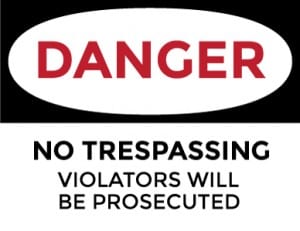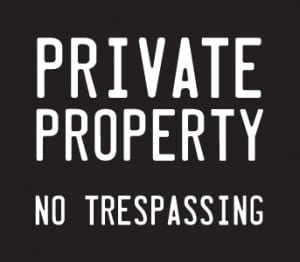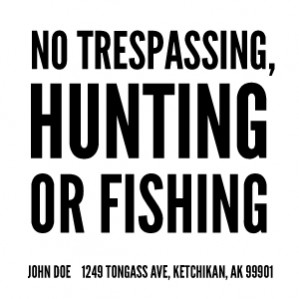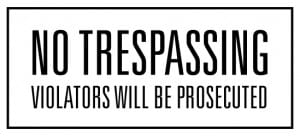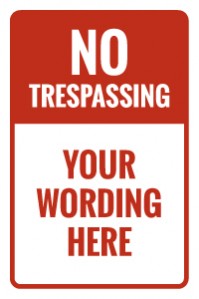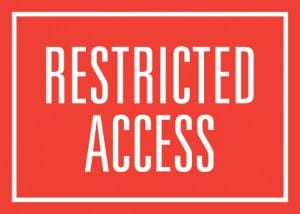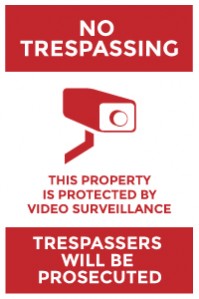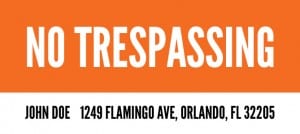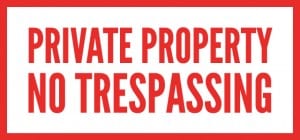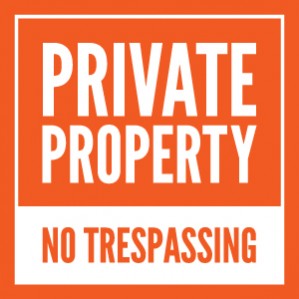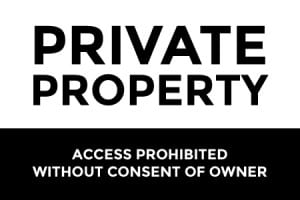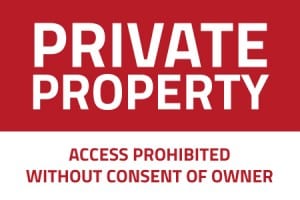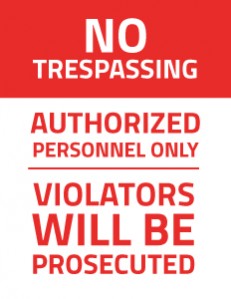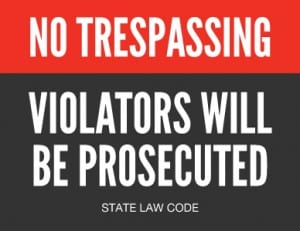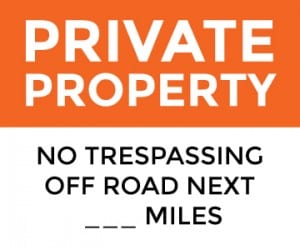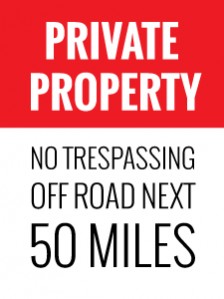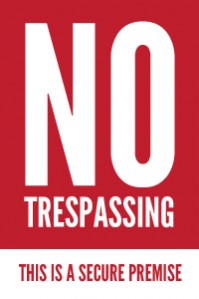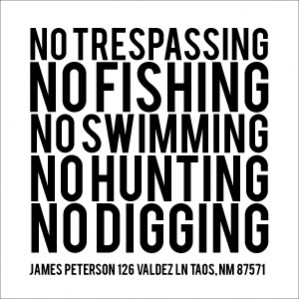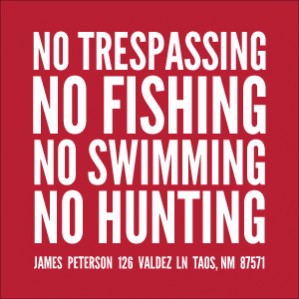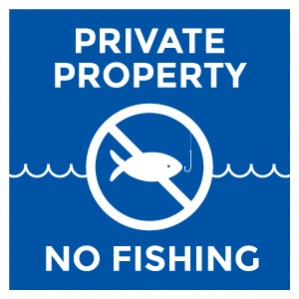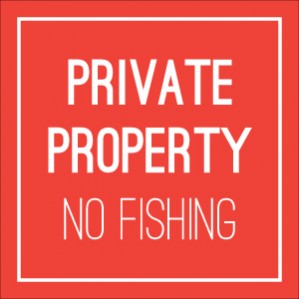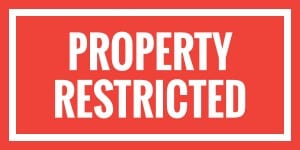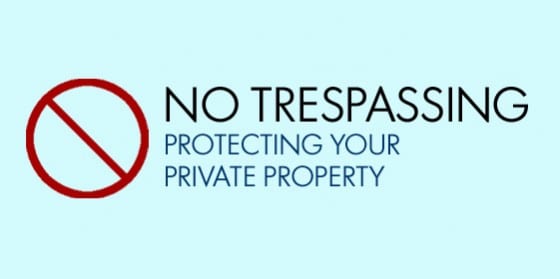
Two of the biggest fears of both business and landowners is liability and the risk of trespassing that comes with owning private property. While we’ve written previously on dog signage and liability, in every state signage plays a slightly different role in legal issues surrounding private property and criminal trespassing.
In addition to preventing trespassing, the reasons for using this type of signage can include a desire for privacy, vandalism and theft prevention, preventing hunting, fishing and trapping, and the obvious liability prevention. After all, private property rights are outlined in the Constitution and, for many, evoke some extremely strong emotions. So from no trespassing to restricted access to private property signs, find your state in the map below to see what types of no trespassing signage will give you legal recourse and help protect your property from ignorant or malicious intruders.
What is Criminal Trespassing?
In most cases criminal trespassing is defined as entering or remaining on a premises or property in which one does not have the authorization, license or privilege to do so. Usually notice against entering or remaining can either be delivered in oral or written fashion by the property owner or an authorized agent. Laws vary slightly from state to state with some being very basic and others having very detailed requirements for providing proper notice.
Trespassing Consequences – Misdemeanor or Felony?
In most states criminal trespassing is punishable by a misdemeanor though in some it is considered a felony. Almost without fail the distinction is based on the situation and intent of the trespasser. Along with being charged with a misdemeanor or felony, trespassing usually comes with some kind of fine and/or imprisonment. In almost all cases property owners have greater legal recourse when they’ve met the state’s definition for proper verbal or written notice.
No Trespassing Signage & Templates
For each state we’ve included examples of the types of signage property owners need to have in place to improve their legal recourse. All of the no trespassing sign templates can be clicked on to customize to your state’s needs. Once clicked on we’d recommend choosing our .040 Aluminum material as an affordable yet durable exterior option while rigid plastic is another good option. As per the note below it is still the responsibility of the buyer to verify that the signage requirement we’ve outlined meets state laws.
Legal Disclaimer
We’ve done our best to find state laws applicable to criminal trespassing on private property. Some states have trespassing laws specific to the type of property. Where possible we’ve noted these differences. Notwithstanding, we are not lawyers and will not be held responsible for information found on this page. Where possible we’ve included a link to state laws or resources that to the best of our knowledge is current state law. Nonetheless, readers are responsible for ascertaining both the law and source are correct before acting on this advice in any way, including the customization of templates and purchase of signs.
Click on the any template below to customize it or find them in our no trespassing templates page.
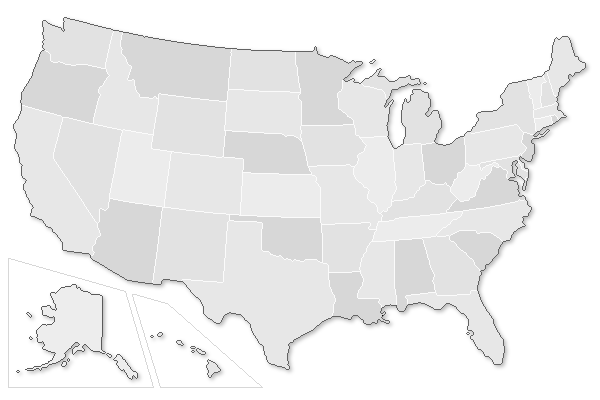
Alabama
Alabama’s no trespassing laws state that one can not enter or remain on buildings, dwellings or private property unless authorized to do so. This authorization can be given by the land owner or an authorized representative. Even land that is unused, unimproved and is neither fenced or designed to exclude trespassers is off limits either through verbal communication or posting of signage in a conspicuous manner.
Alaska
Alaska state laws for no trespassing are laid out in Alaska Statute Title 11 Chapter 46 Section 350, or AS 11.46.350.
In layman’s terms the statute states that assuming the person that has entered and/or remains on land that is neither fenced nor designed to exclude intruders and has no intent to commit a crime can remain on the land unless the following is in place:
-
Notice is given to the person by the owner or by an authorized person that there is no trespassing.
-
Notice is given to the person in a reasonably visible way based on the circumstances.
This notice is sufficient if it meets the following requirements:
-
Legible in English
-
It is at least 144 square inches in size
-
Contains name and address of both the person whose authority is posting the sign and the one that can grant permission to enter
-
Is placed at all known access points to the property
-
If an island, posted at each cardinal point of the island
-
States specific prohibitions such as no digging, hunting, fishing, trespassing, etc.
Arizona
Arizona state laws for trespassing, under AS 13-1502, detail that it is considered trespassing when informed or requested by a land owner, an authorized representative or law enforcement. It is also considered trespassing if “reasonable notice prohibiting entry” has been posted. Definitions of trespassing can be found here in section 13-1501.
Arkansas
Under § 5-39-101 and § 5-39-203 Arkansas state law details that trespassing will be considered whenever someone enters and remains without proper consent from the owner, an authorized representative or when there has been notice posted in a conspicuous manner. If the trespassing involves a vehicle or occupiable structure it is considered a Class B misdemeanor, otherwise it is a Class C misdemeanor.
California
California’s trespassing laws are laid out in the California Penal Code Section 602.8. The law states that any person who enters onto private property that is enclosed or cultivated without written permission from the owner or authorized agent is guilty of trespassing. Further, uncultivated and unenclosed land with signs forbidding trespass “at intervals not less than three to the mile along all exterior roads and trails entering the land” is also considered trespassing. Offenders of the same land or contiguous of the same landowner are fined $75, $250 and charged with a misdemeanor for first, second and third offenses respectively.
Colorado
Colorado no trespassing laws are found in Title 18 Article 4 Part 502 – 504 of Colorado’s Revised Statutes. Trespassing occurs when someone “knowingly and unlawfully enters or remains” in or on a property in which they don’t have authorization or license to do so. Trespassing can either be a felony in criminal situations or a misdemeanor in other instances. There is no specific language concerning “posted” signs or proper notice.
Connecticut
According to CGS § 53a-109 people are guilty of trespassing in Connecticut upon entering and remaining on land that they know they are not licensed or privileged to be on. This includes activities including hunting, fishing, trapping etc. This is applicable to fenced or enclosed areas or “premises that are posted in a manner prescribed by law or reasonably likely to come to the attention of intruders.” These same considerations also apply to both state lands and near state institutions. Trespassers under these circumstances would be charged with an infraction and levied a fine.
Delaware
Delaware trespassing laws are laid out under Delaware Law § 820 – 829. While there are different levels of criminal trespassing the basic definition is similar to many other states. To point, any person who enters and remains unlawfully without consent from the land owner or an authorized person, or enters on a fenced or enclosed area can be found guilty of trespassing. The difference is that there is not verbiage around unenclosed areas and signage that would still cause trespassers to be charged. In particular this is missing from section 829.
Florida
Florida trespassing laws are some of the most detailed in the nation when it comes to trespassing and signage. They are detailed in sections 810.011 (definitions) and 810.08 – 810.12 in particular. Florida defines in great detail different structures and circumstances in which trespassing would be applicable. Notwithstanding, it occurs primarily when someone enters and remains without being authorized to do so. It is also unlawful to damage or remove no trespassing signage.
The signage itself deems the land “posted land” and must meet the following stipulations:
“(5)(a) “Posted land” is that land upon which:
1. Signs are placed not more than 500 feet apart along, and at each corner of, the boundaries of the land, upon which signs there appears prominently, in letters of not less than 2 inches in height, the words “no trespassing” and in addition thereto the name of the owner, lessee, or occupant of said land. Said signs shall be placed along the boundary line of posted land in a manner and in such position as to be clearly noticeable from outside the boundary line; or
2.a. Conspicuous no trespassing notice is painted on trees or posts on the property, provided that the notice is:
(I) Painted in an international orange color and displaying the stenciled words “No Trespassing” in letters no less than 2 inches high and 1 inch wide either vertically or horizontally;
(II) Placed so that the bottom of the painted notice is not less than 3 feet from the ground or more than 5 feet from the ground; and
(III) Placed at locations that are readily visible to any person approaching the property and no more than 500 feet apart on agricultural land.
b. Beginning October 1, 2007, when a landowner uses the painted no trespassing posting to identify a “no trespassing” area, those painted notices shall be accompanied by signs complying with subparagraph 1. and placed conspicuously at all places where entry to the property is normally expected or known to occur.
(b) It shall not be necessary to give notice by posting on any enclosed land or place not exceeding 5 acres in area on which there is a dwelling house in order to obtain the benefits of ss. 810.09 and 810.12 pertaining to trespass on enclosed lands.”
Georgia
Georgia no trespassing laws are similar to those in many other states. They are detailed in the Georgia Statutes and Codes § 16-7-21 – Criminal trespass. Trespassing is when someone knowingly enters and remains on private property without the proper authorization of the owner or an agent. There is no specific verbiage around posted signage other than violators must have received “notice from the owner’ prior to entry – which if interpreted presumably could mean verbal warning or posted signage. Unlike other states this is unclear.
Hawaii
Outlined in §708-814, Hawaii trespassing laws state that a person commits trespassing when they knowingly enter and remain on a property after a reasonable warning by the owner, an authorized representative or law enforcement officer. This is applicable to commercial properties and must be issued within a one year period in which the event took place. It may or may not contain other details as outlined at the link above.
For agricultural lands that are neither enclose nor designed to keep intruders out, signage must be visibly displayed and clearly noticeable from outside the property and include:
-
the words “Private Property”
-
letters not less than 2 inches in height
-
placed along the border of and roads/trails entering into the property
Lastly, unused or unimproved lands needs to have clearly visible signage with some kind of verbiage of “Private Property – No Trespassing” or “Government Property – No Trespassing”. These signs also need to have letters no less than 2 inches high, be visible from outside the property and be placed along the boundaries and entry points.
Idaho
Idaho trespassing laws are covered under Title 18 Chapter 70 – particularly sections 18-7008 and 18-7011. These state that a variety of acts upon real property after knowingly entering where one does not have authorization constitute trespassing. This includes enclosed properties in which “No Trespassing’ signs or other notices of like meaning spaced at intervals of not less than one (1) notice per six hundred sixty (660) feet along such real property.” Further, where the geographical configuration of the real property is such that entry can reasonably be made only at certain points of access, such property is posted sufficiently for all purposes of this section if said signs or notices are posted at such points of access.”
Also, signage can ensure that willful damage and trespassing makes violators guilty of a misdemeanor. In this case, signage must meet the following description:
“Posted with “No Trespassing” signs, is posted with a minimum of one hundred (100) square inches of fluorescent orange, bright orange, blaze orange, safety orange or any similar high visibility shade of orange colored paint except that when metal fence posts are used, a minimum of eighteen (18) inches of the top of the post must be painted a high visibility shade of orange, or other notices of like meaning, spaced at intervals of not less than one (1) sign, paint area or notice per six hundred sixty (660) feet along such real property; provided that where the geographical configuration of the real property is such that entry can reasonably be made only at certain points of access, such property is posted sufficiently for all purposes of this section if said signs, paint or notices are posted at such points of access;”
Illinois
According to Illinois Criminal Code 720 ILCS 5/21-3 trespassing in Illinois occurs when someone knowingly enters without consent or authorization from the owner or an agent. The owner or occupant, amongst other things, must ensure that written notice forbidding entry is posted in a visible way at the main entrance to the land or property or forbidden part. Other markings can include use “purple marks” on poles or trees to prevent trespassing. This is only applicable to municipalities of under 2,000,000 inhabitants. Full details and regulations around this type of marking can be found at the link above.
Indiana
Indiana no trespassing laws are detailed in state code in section IC 35-43-2-2 Version a and IC 35-43-2-2 Version b which deal with the details of criminal trespassing. Violators will be deemed trespassing under a number of different circumstances when they knowingly enter and remain on real property without proper oral or written consent. Specifically, notice can be given by “posting or exhibiting a notice at the main entrance in a manner that is either prescribed by law or likely to come to the attention of the public.” In most cases this will constitute a Class A misdemeanor but can be a Class D felony depending on where the trespassing occurs and whether there have been previous convictions.
Iowa
Trespassing laws for Iowa are explained in Chapter 716 of Iowa Code, specifically section 716.7 defines trespassing. This section lays out all the examples of what can be considered trespassing, even including specific acts such as pursuing animals shot previously on to another property, hunting whitetail deer, etc. In short, trespassing is constituted as entering and/or remaining on property without proper authorization to do so. According to 716.8, which deals with penalties, trespassing constitutes a simple misdemeanor. Depending on what is done during the trespassing incident, violators may be charged with a serious misdemeanor. There is no specific verbiage around posted notice or signage.
Kansas
No trespassing laws for Kansas are explained in Chapter 21 Article 37 of Kansas Statutes and Codes. Specifically 21-3721 details that violators will be found guilty of a criminal trespass, a class B nonperson misdemeanor, when entering and remaining without consent on property as defined in this section. Signage for such laws should be posted so that “such premises or property are posted in a manner reasonably likely to come to the attention of intruders.” Basically, signage need to be clearly labeled and visible to potential intruders to protect your property and have legal recourse.
Kentucky
Kentucky no trespassing laws are outlined in the Kentucky Revised Statutes in Chapter 511. Criminal trespass is defined as someone who “knowingly enters or remains unlawfully in a dwelling.” Depending on the situation trespassing can either be a misdemeanor or a violation. There is no specific language around posted notice or signage.
Louisiana
No trespassing laws for the state of Louisiana are found in RS 14:63. The law states that no person shall enter or remain on property that they do not have written or verbal communication to be on. The definition of property and specific situations are outlined in full detail in section sixty-three. There is no exact verbiage detailing signage requirements or how it may protect property other than to say that warning can be verbal or written. Which presumably means that signage could be used. Trespassing offenses are punishable by fines and/or jail time and escalate with the number of convictions.
Maine
Chapter 17 Section 402 of Maine’s Revised Statutes defines and explains criminal trespassing laws in Maine. Intruders are guilty of trespassing if they enter and remain when not licensed or privileged to do so. Signage plays a key role in areas that are neither fenced or designed to exclude intruders. To point, signage must be posted in a way that is “reasonably likely to come to the attention of the intruder.” Further, signage must meet these requirements:
-
Must indicate that access is prohibited without proper consent or that certain activities are expressly prohibited
-
Signs must be placed at intervals of no greater than 100 feet
-
Signs must be placed at all vehicular access points from public roads
-
Signage is required only for portions of the land that are forbidden
Violators are either guilty of a Class D or Class E crime.
Maryland
Trespassing laws in Maryland are under the Criminal Code in §6–402. Specifically, trespassers can not enter property where signs are placed in a reasonably visible way. Paint marks on trees or posts at each roadway entrance and adjacent to public roadways, waterways and adjoining land also constitutes fair warning. Violators are charged with a misdemeanor and can be fined and/or imprisoned. Unless noted elsewhere, Maryland has some of the least defined laws in regards to property and trespassing when compared to the rest of the United States.
Massachusetts
Trespassing laws for Massachusetts are laid out in several different sections of their state laws. In particular, sections 115, 120 and others between sections 120B and 123 lay out trespassing details. In essence, violators can’t enter or remain on property unless they have written or verbal consent to do so. The laws do not state any stringent details for signage except to say that “notice posted thereon” can constitute sufficient notice. Those found guilty can be fined and/or imprisoned depending on the actual offense.
Michigan
Similar to Massachusetts, Michigan lays out trespassing violations in various sections of their law. The one most pertinent to private property is found in Section 750.552. This section states that a person can not enter or remain without lawful authority to do so or after being notified to depart. No specific language for signage is noted in this section. Guilty parties are charged with a misdemeanor and may face fines and or incarceration.
Minnesota
Trespassing laws for Minnesota are detailed in the 2013 Minnesota Statutes in Section 609.605. Persons entering and/or remaining without proper consent will be found to have trespassed. Minnesota laws are some of the most detailed in the nation and outline many different definitions for sites and actions related to trespassing. The law also outlines a number of requirements for what they call “posted” notice for different settings. Namely, that signage for a locked building must be:
-
8.5” x 11” in size
-
be placed in a conspicuous place on the exterior of the building, or a visible spot on the property in which the building sits
-
must carry a general notice warning against trespass
Further, for construction areas of greater size the number of signs that is required goes up for each full 10 acres of land. The sign must be 8.5” x 11” in size and be place in a conspicuous manner. Signage for a mining location must meet similar requirements including:
“(A) carry a general notice warning against trespass;
(B) display letters at least two inches high;
(C) state that Minnesota law prohibits trespassing on the property; and
(D) are posted in a conspicuous place and at intervals of 500 feet or less.”
With some of the most detailed laws, land and property owners would be wise to read these guidelines carefully straight from the source as linked to above. Violators can be charged in various ways depending on the situation.
Mississippi
The 2010 Mississippi Code 97-17-97 defines trespassing in Mississippi as “going into or upon, or remaining in or upon, buildings, premises or lands of another after being forbidden to do so.” Forbidding someone from doing this can either be verbal or written notice. When signage is used it must meet the following stipulations:
-
Sign(s) need to posted where they can be reasonably seen
-
Can be placed on or in the building or part or portion of the forbidden place.
In layman’s terms, signage of reasonable size and placement communicating “no trespassing” should be sufficient. Guilty persons are charged with a misdemeanor and can be fined and/or imprisoned.
Missouri
No trespassing laws in Missouri are detailed in sections 569.140 to 569.155. Upon entering and remaining without proper authorization a person is found guilty of first degree trespass. This is considered a Class B misdemeanor. This occurs only when the property is fenced or enclosed in a way to exclude intruders, it is communicated verbally or posted in a manner which is reasonably likely to be seen. So like many some other states a simple no trespassing sign of good size and a clear message will suffice. Similar to Illinois, purple paint to mark streets and posts can also be used and is detailed here.
Montana
Criminal trespassing laws for Montana are outlined in Montana Code Section 45-6-201. Entering and remaining without the license or privilege to do so constitutes trespassing in Montana. Though privilege to do so in Montana’s case can be the simple failure of the landowner to “post notice denying entry onto private land.”
This signage must meet the following requirements:
“(a) notice must be placed on a post, structure, or natural object by marking it with written notice or with not less than 50 square inches of fluorescent orange paint, except that when metal fence posts are used, the entire post must be painted; and
(b) the notice described in subsection (2)(a) must be placed at each outer gate and normal point of access to the property, including both sides of a water body crossing the property wherever the water body intersects an outer boundary line.
(3) To provide for effective posting of private land through which or along which the public has an unfenced right-of-way by means of a public road, a landowner shall:
(a) place a conspicuous sign no closer than 30 feet of the centerline of the roadway where it enters the private land, stating words substantially similar to “PRIVATE PROPERTY, NO TRESPASSING OFF ROAD NEXT ___ MILES”; or
(b) place notice, as described in subsection (2)(a), no closer than 30 feet of the centerline of the roadway at regular intervals of not less than one-fourth mile along the roadway where it borders unfenced private land, except that orange markings may not be placed on posts where the public roadway enters the private land.
(4) If property has been posted in substantial compliance with subsection (2) or (3), it is considered closed to public access unless explicit permission to enter is given by the landowner or his authorized agent.”
Nebraska
Nebraska trespassing laws are laid out in the 2008 Nebraska Revised Statutes in 28:520 – 28:522. Criminal trespassing is constituted by entering and or secretly remaining in buildings or land that one is not “licensed or privileged” to enter. There are different degrees of criminal trespass in Nebraska as outlined in the sections noted above. Signage, “when posted in a manner prescribed by law or reasonably likely to come to the attention of intruders” elevates the crime to second degree. Thus, visible signage denoting “No Trespassing” ensures that intruders will be subject to tougher penalties.
Nevada
Criminal trespassing laws in Nevada are part of Chapter 207 of Nevada’s Revised Statutes. NRS 207.200 states that anyone who willfully goes upon or remains on land where they not authorized to be is guilty of trespassing and will be charged with a misdemeanor. This occurs after having been warned, which means some kind of generic no trespassing signage needs to be present.
Further, more stringent signage regulations are outlined for land with agricultural purposes. These are:
“by painting with fluorescent orange paint:
(1) Not less than 50 square inches of the exterior portion of a structure or natural object or the top 12 inches of the exterior portion of a post, whether made of wood, metal or other material, at:
(I) Intervals of such a distance as is necessary to ensure that at least one such structure, natural object or post would be within the direct line of sight of a person standing next to another such structure, natural object or post, but at intervals of not more than 1,000 feet; and
(II) Each corner of the land, upon or near the boundary; and
(2) Each side of all gates, cattle guards and openings that are designed to allow human ingress to the area;
(b) If the land is not used in the manner specified in paragraph (a), by painting with fluorescent orange paint not less than 50 square inches of the exterior portion of a structure or natural object or the top 12 inches of the exterior portion of a post, whether made of wood, metal or other material, at:
(1) Intervals of such a distance as is necessary to ensure that at least one such structure, natural object or post would be within the direct line of sight of a person standing next to another such structure, natural object or post, but at intervals of not more than 200 feet; and
(2) Each corner of the land, upon or near the boundary;”
New Hampshire
Laws for trespassing in New Hampshire are outlined in New Hampshire’s Revised Statutes. The details of the laws are specifically found in Section 635:2. The person is guilty of trespassing when they knowingly enter or remain in any place they are not authorized to be in. Any trespassing in a “secured premises” warrants a misdemeanor. This means that it needs to be fenced, posted, enclosed so as to exclude intruders or have warning that is “reasonably likely to come to the attention of the intruder.” This means that signage can ensure that the property or land is considered a “secured premises.” Subsequent violations of the law will result in a class B felony when the perpetrator causes damage exceeding $1,500 in value.
New Jersey
New Jersey trespassing laws are outlined in Section 2C:18-3 of the New Jersey Statutes. Trespassing is defined as someone who “enters or surreptitiously remains” in any building or land that he/she is not privileged to do so. Notice is given by actual communication from an authorized person, fencing or an enclosure designed to exclude intruders, or posting in a way that is “reasonably likely to come to the attention of intruders.” Thus, signage with the verbiage of “No Trespassing” of good size should constitute fair warning. Depending on the facility or land this offense can be a crime of the fourth degree or a simple petty disorderly persons offense.
New Mexico
No trespassing laws in New Mexico are outlined in Chapter 30 Article 14 of New Mexico’s Statutes and Court Rules. Similar to many other states simple trespassing is defined as knowingly entering and remaining on property without verbal or written permission to do so. Criminal trespassing merits a misdemeanor and can also mean the loss of a hunting or fishing license. Removing no trespassing signage also results in a misdemeanor.
Specific signage laws in regards to no trespassing are outlined in 30-14-6. Real property requires that notice be placed along the exterior boundaries of the property or other access points in a visible manner. Unfenced property requires signage to be posted every 500 feet along the boundary of the property. This signage needs to meet the following requirements:
“(1) be printed legibly in English;
(2) be at least one hundred forty-four square inches in size;
(3) contain the name and address of the person under whose authority the property is posted or the name and address of the person who is authorized to grant permission to enter the property;
(4) be placed at each roadway or apparent way of access onto the property, in addition to the posting of the boundaries; and
(5) where applicable, state any specific prohibition that the posting is directed against, such as “no trespassing,” “no hunting,” “no fishing,” “no digging” or any other specific prohibition.”
New York
The state of New York’s criminal trespassing are detailed in Article 140 within the Penal section of the New York Codes & Statutes. In New York, regardless of intent, criminal trespassing is constituted by entering and remaining when the intruder is neither licensed nor privileged to do so. Signage plays a critical role in trespassing as unposted or insufficient notice can absolve trespassers of guilt in certain situations. Signage needs to be based in a conspicuous manner on the property to ensure that proper notice is given. Based off the circumstances, trespassing can result in misdemeanors of varying degrees and even a felony for the worst cases.
North Carolina
North Carolina trespassing laws are contained in Chapter 14 of North Carolina’s General Statutes and more specifically in Article 159. Trespassing punishments vary based on circumstances but the act itself is defined by entering or remaining without authorization. For most situations signage “that is posted, in a manner reasonably likely to come to the attention of intruders, with notice not to enter the premises” is sufficient notice. Though for “posted” property with the intent to prevent hunting, fishing, trapping or the removal of pine needles/straw the signage requirements are much more stringent and laid out below. These are found in § 14-159.7.
“For purposes of posting property under G.S. 14-159.7, the owner or lessee of the property may use either of the following methods:
(1) The owner or lessee of the property may place notices, signs, or posters on the property. The notices, signs or posters shall measure not less than 120 square inches and shall be conspicuously posted on private lands not more than 200 yards apart close to and along the boundaries. At least one such notice, sign, or poster shall be posted on each side of such land, and one at each corner thereof, provided that said corner can be reasonably ascertained. For the purpose of prohibiting fishing, or the taking of fish by any means, in any stream, lake, or pond, it shall only be necessary that the signs, notices, or posters be posted along the stream or shoreline of a pond or lake at intervals of not more than 200 yards apart.
(2) The owner or lessee of the property may place identifying purple paint marks on trees or posts around the area to be posted. Each paint mark shall be a vertical line of at least eight inches in length, and the bottom of the mark shall be no less than three feet nor more than five feet from the base of the tree or post. The paint marks shall be placed no more than 100 yards apart and shall be readily visible to any person approaching the property. For the purpose of prohibiting fishing, or the taking of fish by any means, in any stream, lake, or pond, it shall only be necessary that the paint marks be placed along the stream or shoreline of a pond or lake at intervals of not more than 100 yards apart. (1949, c. 887, s. 2; 1953, c. 1226; 1965, c. 923; 1975, c. 280, ss. 2, 3; 1979, c. 830, s. 11; 2011-231, s. 2.)”
North Dakota
No trespassing laws in North Dakota are found in 12.1-22-03 under criminal trespass. Any person knowing that they do not have privilege nor license enters or remains is guilty of criminal trespassing. Depending on the situation penalties can range from a Class A misdemeanor to a Class C felony. Like many other states, sufficient notice (i.e. signage) is defined as “posting in a manner reasonably likely to come to the attention of intruders.”
Ohio
Trespassing in Ohio law is outlined in 2911.21 of Ohio’s Statutes. While penalties may differ a little bit based off where the trespassing occurs, it is considered a “misdemeanor of the fourth degree.” In order to give notice, signage or “posting” must be “in a manner reasonably calculated to come to the attention of potential intruders.”
Oklahoma
Oklahoma defines criminal trespassing in Oklahoma Statutes 21-1835. It states that any person who “willfully or maliciously” enters without permission is guilty of trespassing. Penalties of trespassing include fines and possible imprisonment of varying amounts and time. Oklahoma defines “posted” (i.e. to give notice) as “exhibiting signs to read as follows: “PROPERTY RESTRICTED”; “POSTED – KEEP OUT”; “KEEP OUT”; “NO TRESPASSING”; or similar signs which are displayed. Property that is fenced or not fenced must have such signs placed conspicuously and at all places where entry to the property is normally expected.”
Oregon
Oregon’s trespassing definition and penalties are found in Oregon Statutes 164 under the Burglary and Criminal Trespass section. Trespassing occurs when someone enters and remains unlawfully on a property or premises in which they don’t have permission to be on. Offenders can be found guilty of crimes of varying degrees based on the type of property and situation. There is no specific language on signage, a “posted” definition or proper notice.
Pennsylvania
Criminal trespassing laws in Pennsylvania are found in Title 18 – Crimes and Offenses Section 3503. Pennsylvania’s wording is almost verbatim of many other states in that “a person commits an offense if, knowing that he is not licensed or privileged to do so,” enters and remains on property. Trespassing is contingent on the circumstances and guilty parties can be charged with misdemeanors or felonies. Similarly, wording for signage or “posted” notice is very similar in that it must be “posted in a manner prescribed by law or reasonably likely to come to the attention of intruders.” In other words, make sure to have an obvious sign stating that there is no trespassing and you will have legal recourse.
Rhode Island
Rhode Island’s no trespassing laws are found in Rhode Island’s Statutes in sections 11-44-26 to 11-44-28. Trespassers are those who willfully trespass and remain on the land with no purpose to do so and lacking permission. This must occur after having been forbidden to do so by those authorized. The statute doesn’t state whether this can be verbal or some kind of written notice but it is assumed that it could be either. Thus, presumably some kind of no trespassing signage that is visible would be sufficient. Penalties may result in a fine of up to $1,000 and imprisonment not exceeding one year, or both.
South Carolina
South Carolina outlines its criminal trespassing in its statutes in various places including 16-11-640. In essence they are the same as many of the other states in that a person entering and remaining when having no permission to do so will be guilty of trespassing. Offenders will be subject to varying levels of crimes, fines and potential imprisonment.
As for signage, agricultural lands require posting of notice in conspicuous places on the four borders of the land. Further, even enclosed places must have “clearly visible signs prohibiting trespass upon the premises.”
South Dakota
South Dakota no trespassing laws are similar to other more rural states and are detailed in Chapter 22-35 of South Dakota’s Codified Laws. The state definition is: “Any person who, knowing that he or she is not privileged to do so, enters or remains in any building or structure surreptitiously, is guilty of criminal trespass.” This person will be guilty of criminal trespass and will be charged with a Class 1 misdemeanor. Notice must be given to the offender before the act, either verbally or in “posting in a manner reasonably likely to come to the attention of trespassers.”
Tennessee
Tennessee trespassing laws are explained in full in Tennessee Code 39-14-405. The law states that a person commits trespassing by entering or remaining on property without the proper consent. This offense is a Class C misdemeanor. Signage requirements are that the property owner must have signs that are visible at all major points of access or entry to the property and that they are reasonably likely to be seen by any person entering the property.
Texas
The state of Texas details its no trespassing laws in its Penal Code in Title 7 Chapter 30. Criminal trespass is defined as a person entering or remaining on or in property without “effective consent.” To be considered trespassing there must be verbal or written notice. If unfenced, written notice can be done in two ways. These are:
(C) a sign or signs posted on the property or at the entrance to the building, reasonably likely to come to the attention of intruders, indicating that entry is forbidden;
(D) the placement of identifying purple paint marks on trees or posts on the property, provided that the marks are:
(i) vertical lines of not less than eight inches in length and not less than one inch in width;
(ii) placed so that the bottom of the mark is not less than three feet from the ground or more than five feet from the ground; and
(iii) placed at locations that are readily visible to any person approaching the property and no more than:
(a) 100 feet apart on forest land; or
(b) 1,000 feet apart on land other than forest land;
In most cases guilty offenders will be charged with a misdemeanor.
Utah
Utah trespassing laws are defined in the Utah Criminal Code in Title 76 Chapter 6 Section 206. Trespassing is the entering and remaining on property without consent. Along with a few other stipulations, notice must be given verbally or “in a way that will reasonably likely to come to the attention of intruders.” Guilty parties will be charged with a class B or A misdemeanor.
Vermont
Vermont Statutes lay out the details of no trespassing laws in the state. Unlawful trespass is found in Title 13 Chapter 81 Section 3705. When proper notice is given, trespassers who enter or remain on any land or place shall be subject to up to 3 months in prison and a fine of $500, or both. Sufficient notice can be done verbally or through “signs or placards so designed and situated as to give reasonable notice.”
Virginia
Virginia no trespassing laws are detailed and varied and are found in the Code of Virginia Title 18.2 Sections 119 – 135. The law states that any person without authority who enters or remains on property or premises will be guilty of criminal trespassing. Consent can be given orally or in written fashion. Signage forbidding such entry should be placed on the “premises or portion or area thereof at a place or places where it or they may be reasonably seen.” Guilty parties will be charged with a Class 1 misdemeanor. Trespassers may be guilty in several different situations including hunting, fishing or trapping. In particular, property owners using signage for these situations need to place:
“signs prohibiting hunting, fishing or trapping where they may reasonably be seen; or (ii) placing identifying paint marks on trees or posts at each road entrance and adjacent to public roadways and public waterways adjoining the property. Each paint mark shall be a vertical line of at least two inches in width and at least eight inches in length and the center of the mark shall be no less than three feet nor more than six feet from the ground or normal water surface. Such paint marks shall be readily visible to any person approaching the property.
B. The type and color of the paint to be used for posting shall be prescribed by the Department of Game and Inland Fisheries.”
Washington
The Washington Criminal Code contains Washington trespassing laws. Details can be found in Title 9A.52. In Washington, to enter and remain unlawfully without privilege or license constitutes trespassing. Trespassing in such a manner is considered a misdemeanor. Signage plays a key role particularly in situations where land is unused or otherwise not enclosed as notice can be given by being posted in a conspicuous manner. In other words some kind of basic no trespassing sign posted in an obvious and visible manner will be sufficient to give the property owner legal recourse.
West Virginia
West Virginia’s no trespassing laws are explained in Chapter 61 Article 61-3B. West Virginia’s definition of criminal trespassing is, “willful unauthorized entry upon, in or under the property of another.” In most instances this is punishable by a misdemeanor and a fine but in some cases this can be a felony. Signage requirements for “posted” land are as follows:
“‘Posted land’ is that land upon which reasonably maintained signs are placed not more than five hundred feet apart along and at each corner of the boundaries of the land, upon which signs there appears prominently in letters of not less than two inches in height the words “no trespassing” and in addition thereto the name of the owner, lessee or occupant of the land. The signs shall be placed along the boundary line of posted land in a manner and in a position as to be clearly noticeable from outside of the boundary line. It shall not be necessary to give notice by posting on any enclosed land or place not exceeding five acres in area on which there is a dwelling house or property that by its nature and use is obviously private in order to obtain the benefits of this article pertaining to trespass on enclosed lands.”
Wisconsin
Wisconsin no trespassing laws are found in the crimes against property section which is Chapter 943. They are specifically found in 943.13 – 943.15. To enter or remain on “enclosed, cultivated or undeveloped land of another…without the express or implied consent of the owner or occupant” is how Wisconsin defines trespassing. In most cases this is considered some Class of a misdemeanor and may involve a forfeiture. Wisconsin gives lots of details on signage in regards to trespassing or “posted” land.
Notice can come through signs if it meets the following:
“1. If a sign at least 11 inches square is placed in at least 2 conspicuous places for every 40 acres to be protected. The sign must provide an appropriate notice and the name of the person giving the notice followed by the word “owner” if the person giving the notice is the holder of legal title to the land and by the word “occupant” if the person giving the notice is not the holder of legal title but is a lawful occupant of the land. Proof that appropriate signs as provided in this subdivision were erected or in existence upon the premises to be protected prior to the event complained of shall be prima facie proof that the premises to be protected were posted as provided in this subdivision.
2. If markings at least one foot long, including in a contrasting color the phrase “private land” and the name of the owner, are made in at least 2 conspicuous places for every 40 acres to be protected.”
Property owners must also use a sign that is at least 5” x 7” that is “located in a prominent place near all of the entrances to the part of the building to which the restriction applies or near all probable access points to the grounds to which the restriction applies and any individual entering the building or the grounds can be reasonably expected to see the sign in order to prevent firearms from being carried in various situations and settings.
Wyoming
No trespassing laws in Wyoming are found in the Wyoming Statutes in Title 6 Chapter 3 Article 303. It states that a person is guilty of trespassing when they enter or remain on or in the land or premises of another person without authorization to do so, or after being notified of such. This is punishable by a misdemeanor and can carry imprisonment of not more than 6 months and a fine not exceeding $750, or both. Notice can either be given personally from the owner or agent or through “posting of signs reasonably likely to come to the attention of intruders.”






























